2022 Kawasaki Ninja H2
The Ninja H2 and Ninja H2 Carbon motorcycles amount to pure street-legal hypersport performance. Featuring a 998cc inline four-cylinder engine, proprietary supercharger, lightweight trellis frame, compact superbike dimensions, aerodynamic bodywork, and a rigid single-sided swingarm. Both models feature high-spec Brembo Stylema brake calipers, Kawasaki Quick Shifter (KQS), Kawasaki Traction Control (KTRC-9 modes) and Kawasaki’s highly durable self-healing paint. In the cockpit, a TFT (thin-film transistor) color instrumentation display with four selectable display modes can be found, as well as Bluetooth Smartphone Connectivity via RIDEOLOGY THE APP*. Bringing all this power and technology to the pavement are Bridgestone RS11 tires. The Ninja H2 Carbon was developed as a special, limited-edition model that features beautiful, strong, and lightweight carbon fiber front bodywork and special insignia.
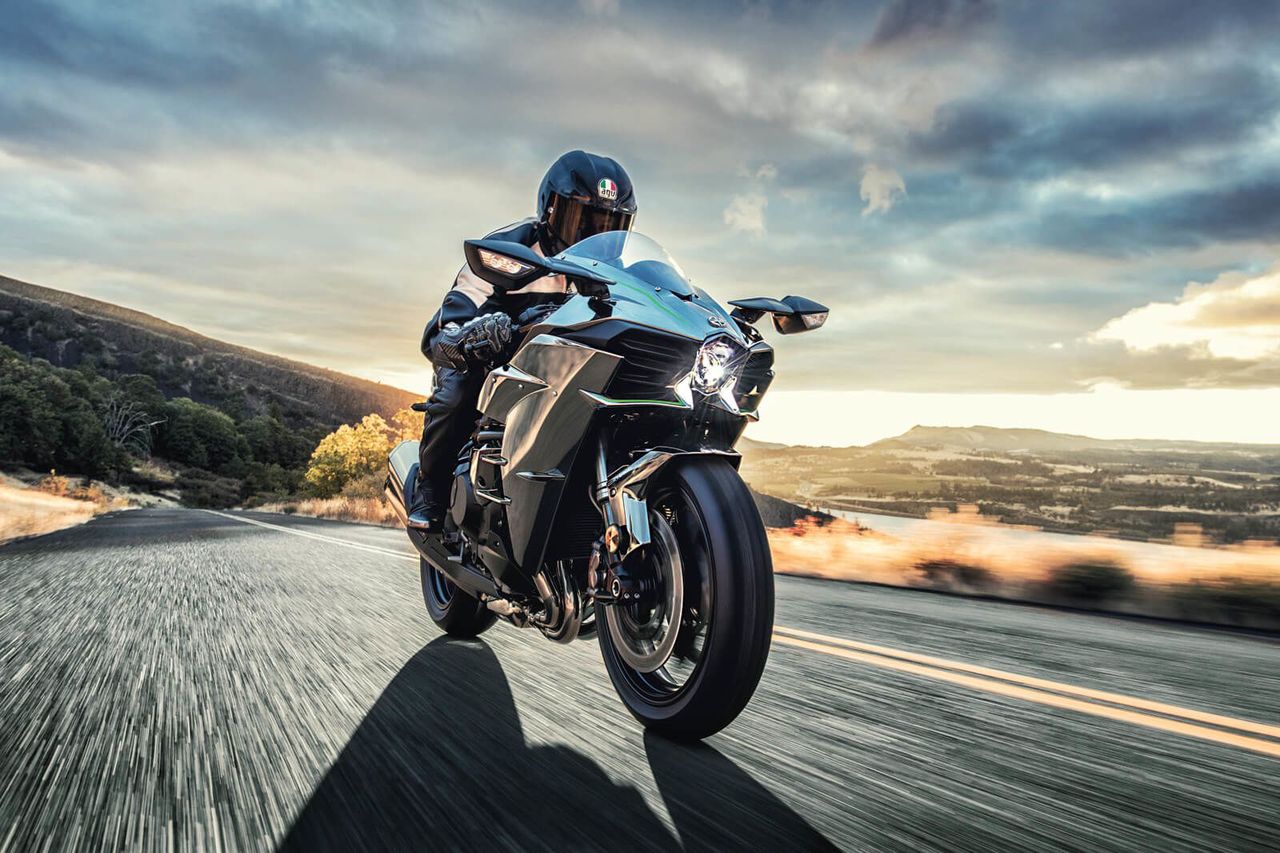
The Kawasaki Ninja H2 is designed to be the ultimate performance street-legal motorcycle, built using state of the art technologies with cooperative development across Kawasaki’s high-performance motorcycle, aerospace and gas turbine divisions.
The Kawasaki 2022 line of hypersport motorcycles returns stronger than ever with its high-performance and supercharged Ninja H2R, Ninja H2 and Ninja H2 Carbon models.
The Ninja H2 and Ninja H2 Carbon motorcycles bring the mind-bending power of Kawasaki’s supercharged hypersport racer to the street. Boasting a powerful 998cc inline four-cylinder engine, state-of-the-art electronics, and the latest Brembo brakes, the Ninja H2 and Ninja H2 Carbon amount to pure performance on the road.
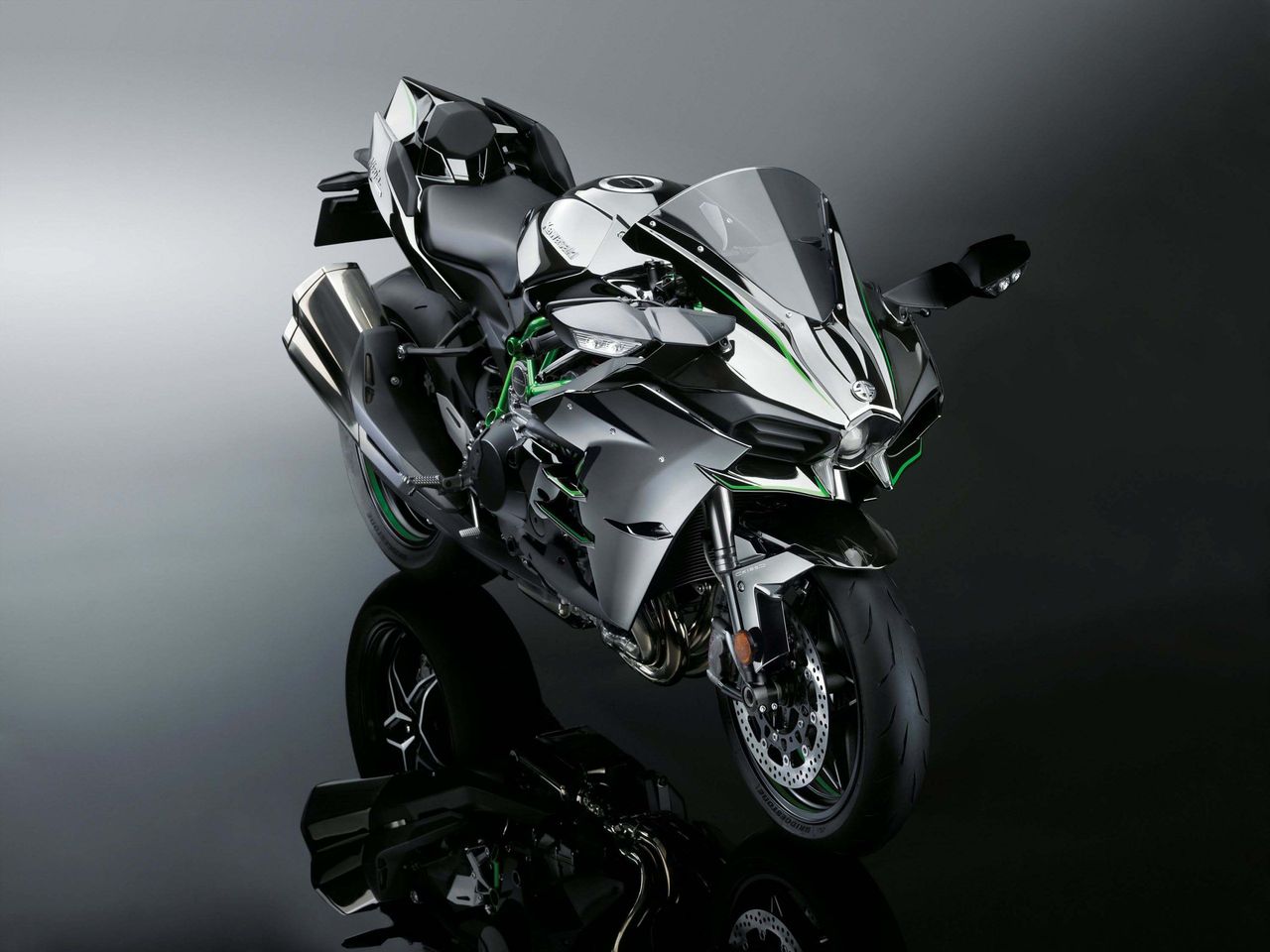
2022 Kawasaki Ninja H2 Key Features
KAWASAKI PROPRIETARY SUPERCHARGED TECHNOLOGY DELIVERS EXCEPTIONAL POWER AND
TORQUE FOR THE ULTIMATE RIDING EXPERIENCE
TRELLIS FRAME OPTIMIZES HANDLING AND EFFECTIVELY VENTS ENGINE HEAT
OHLINS TTX36 SHOCK
AEROSPACE-DESIGNED BODYWORK HELPS CREATE DOWNFORCE
HIGH-TECH TFT COLOR INSTRUMENTATION IS EASIER TO READ
SMARTPHONE CONNECTIVITY ENABLES RIDERS TO CONNECT TO THE MOTORCYCLE WIRELESSLY
KYB AOS-II FRONT FORK
KAWASAKI TRACTION CONTROL (9 MODES)
2022 Kawasaki Ninja H2 Features and Benefits
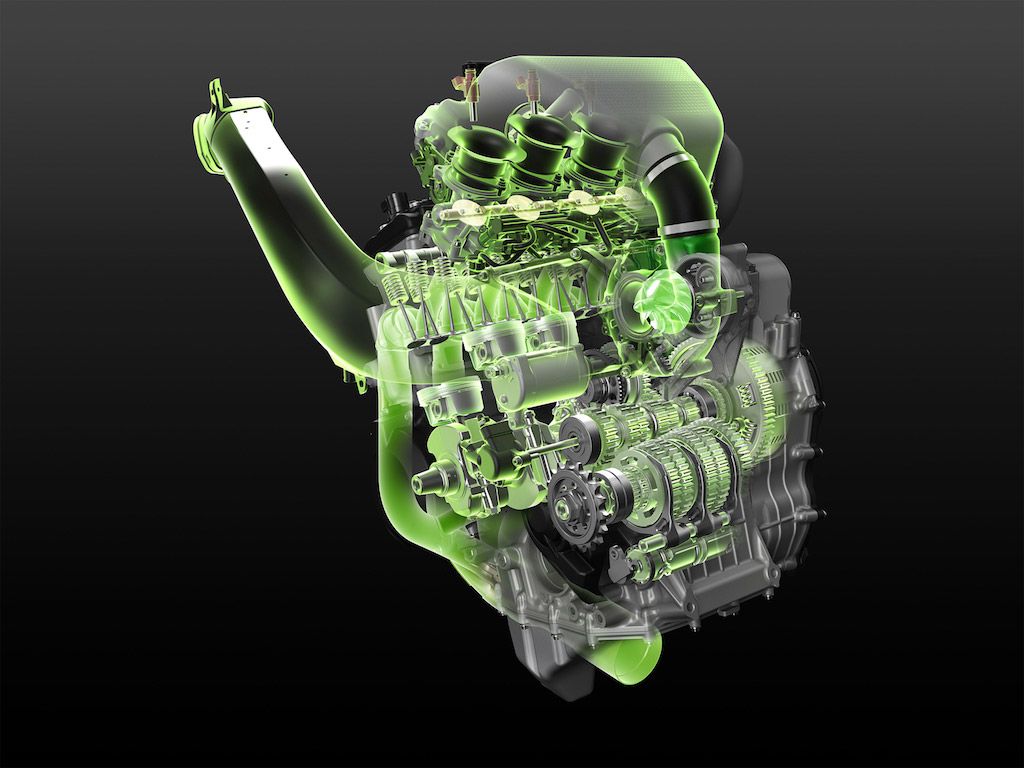
Assist & Slipper Clutch
Based on feedback from racing activities, the Assist & Slipper Clutch uses two types of cams (an assist cam and a slipper cam) to either drive the clutch hub and operating plate together or apart.
Under normal operation, the assist cam functions as a self-servo mechanism, pulling the clutch hub and operating plate together to compress the clutch plates. This allows the total clutch spring load to be reduced, resulting in a lighter clutch lever feel when operating the clutch.
When excessive engine braking occurs – as a result of quick downshifts (or an accidental downshift) – the slipper cam comes into play, forcing the clutch hub and operating plate apart. This relieves pressure on the clutch plates to reduce back-torque and helps prevent the rear tire from hopping and skidding. This race-style function is particularly useful when sport or track riding.
Economical Riding Indicator
Using high-precision electronic control for engine management, Kawasaki models can achieve a high level of fuel efficiency. However, fuel consumption is greatly affected by throttle use, gear selection, and other elements under the rider’s control. The Economical Riding Indicator is a function that indicates when current riding conditions are consuming a low amount of fuel. The system continuously monitors fuel consumption, regardless of vehicle speed, engine speed, throttle position and other riding conditions. When fuel consumption is low for a given speed (i.e. fuel efficiency is high), an “ECO” mark appears on the instrument panel’s LCD screen. By riding so that the “ECO” mark remains on, fuel consumption can be reduced.
While effective vehicle speed and engine speed may vary by model, paying attention to conditions that cause the “ECO” mark to appear can help riders improve their fuel efficiency – a handy way to increase cruising range. Further, keeping fuel consumption low also helps minimize negative impact on the environment.
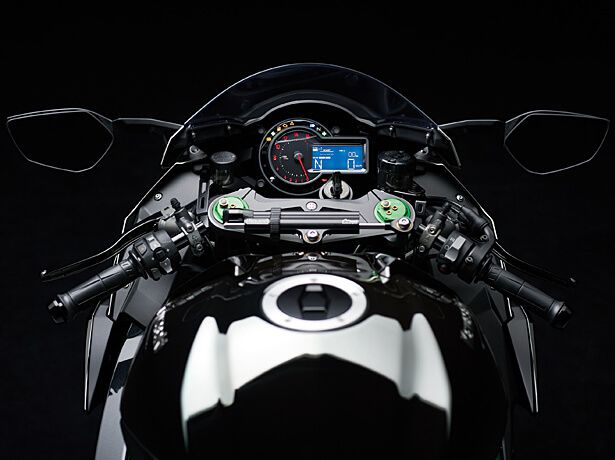
Kawasaki Engine Brake Control system
The Kawasaki Engine Brake Control system allows riders to select the amount of engine braking they prefer. When the system is activated, the engine braking effect is reduced, providing less interference when riding on the track.
KLCM (Kawasaki Launch Control Mode)
Designed to assist riders by optimizing acceleration from a stop, KLCM electronically manages engine output to minimize wheel spin when moving off. With the clutch lever pulled in and the system activated, engine speed is limited to a determined speed while the rider holds the throttle open. Once the rider releases the clutch lever to engage the clutch, engine speed is allowed to increase, but power is regulated to minimize wheel spin and help keep the front wheel on the ground. The system disengages automatically once a predetermined speed has been reached, or when the rider shifts into third gear. Depending on the model, riders can choose from multiple modes, each offering a progressively greater level of intrusion.
KCMF (Kawasaki Cornering Management Function)
Using the latest evolution of Kawasaki’s advanced modeling software and feedback from a compact IMU (Inertial Measurement Unit) that gives an even clearer real-time picture of chassis orientation, KCMF monitors engine and chassis parameters throughout the corner – from entry, through the apex, to corner exit – modulating brake force and engine power to facilitate smooth transition from acceleration to braking and back again, and to assist riders in tracing their intended line through the corner. The systems that KCMF oversees vary by model, but may include:
• S-KTRC/KTRC (including traction management and wheel lift management)
• KLCM (including traction management and wheel lift management)
– Designed to optimize acceleration from a stop
• KIBS (including pitching management and corner braking management)
• Kawasaki Engine Brake Control
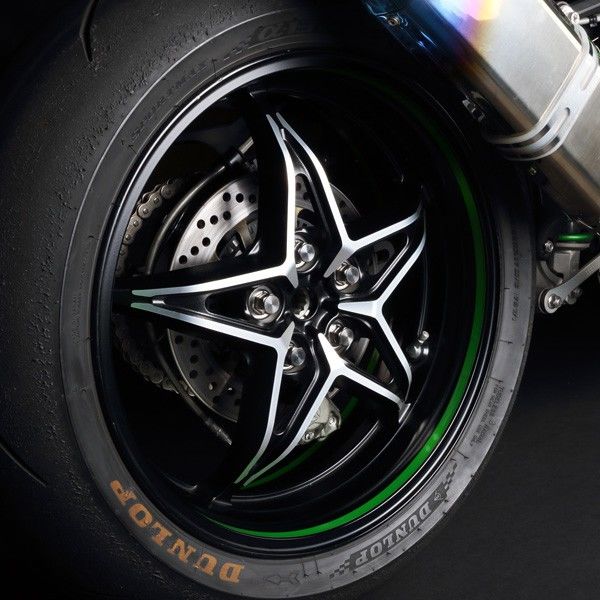
KTRC (Kawasaki Traction Control)
KTRC, Kawasaki’s advanced traction control system provides both enhanced sport riding performance and the peace of mind to negotiate slippery surfaces with confidence. Multiple rider-selectable modes (the number of modes varies by model) offer progressively greater levels of intrusion to suit the riding situation and rider preference.
Less intrusive modes maintain optimum traction during cornering. Designed with sport riding in mind, they facilitate acceleration out of corners by maximizing forward drive from the rear wheel. And because Kawasaki’s sophisticated software bases its dynamic analysis on the chassis’ orientation relative to the track surface (rather than relative to a horizontal plane), it is able to take into account corner camber, gradient, etc., and adapt accordingly.
In the more intrusive modes (and for some models, in any mode), when excessive wheel spin is detected, engine output is reduced to allow grip to be regained, effectively enabling riders to negotiate both short, slippery patches (train tracks or manhole covers) and extended stretches of bad roads (wet pavement, cobblestone, gravel) with confidence.
Smartphone Connectivity
Clever technology enables riders to connect to their motorcycle wirelessly. Using the smartphone application “RIDEOLOGY THE APP,” a number of instrument functions can be accessed, contributing to an enhanced motorcycling experience. Vehicle information (such as the odometer, fuel gauge, maintenance schedule, etc) can be viewed on the smartphone. Riding logs (varies by model, but may include GPS route, gear position, rpm, and other information) can be viewed on the smartphone. When connected, telephone (call, mail) notices are displayed on the instrument panel. Riders can also make changes to their motorcycle’s instrument display settings (preferred units, clock and date setting, etc) via the smartphone. And on certain models, it is even possible to check and adjust vehicle settings (such as Rider Mode, electronic rider support features, and payload settings) using the smartphone.
Supercharged Engine
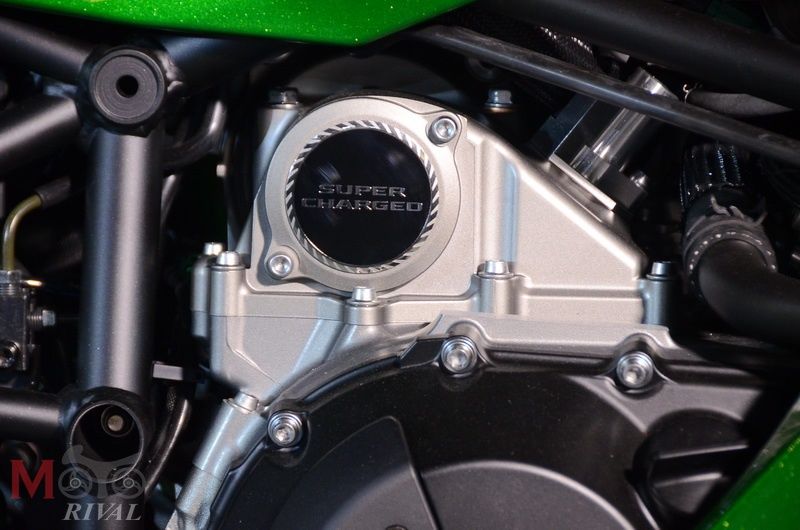
Drawing on the know-how and technology possessed by the Kawasaki Heavy Industries, Ltd. (KHI), Kawasaki’s supercharged engine delivers high engine output while maintaining a compact design. The key to achieving this incredible performance lies in the engine’s supercharger – a motorcycle-specific unit designed completely in-house with technology from the Kawasaki Gas Turbine & Machinery Company, Aerospace Company and Corporate Technology Division.
One of the greatest benefits of designing the supercharger in-house and tailoring its design to match the engine’s characteristics was that engineers were able to achieve high-efficiency operation over a wide range of conditions – something that would not have been possible by simply dropping in or trying to adapt an aftermarket automotive supercharger.
The importance of high efficiency in a supercharger is that, as the air is compressed, power-robbing heat gain is minimal. And while many superchargers are able to offer high-efficiency operation in a very limited range of conditions, the Kawasaki supercharger offers high efficiency over a wide range of pressure ratios and flow rates – meaning over a wide range of engine speeds and vehicle speeds. This wide range of efficient operation (similar to having a wide power band) easily translates to strong acceleration. The supercharger’s high efficiency and minimal heat gain also meant that an intercooler was unnecessary, greatly saving weight and space, and enabling the engine’s compact design.
KQS (Kawasaki Quick Shifter)
Designed to help riders maximize their acceleration on the track by enabling clutchless upshifts with the throttle fully open, KQS detects that the shift lever has been actuated and sends a signal to the ECU to cut ignition so that the next gear can be engaged without having to use the clutch. On models that offer clutchless downshifts, during deceleration the system automatically controls engine speed so that the next lower gear can be selected without operating the clutch.
Kawasaki ABS
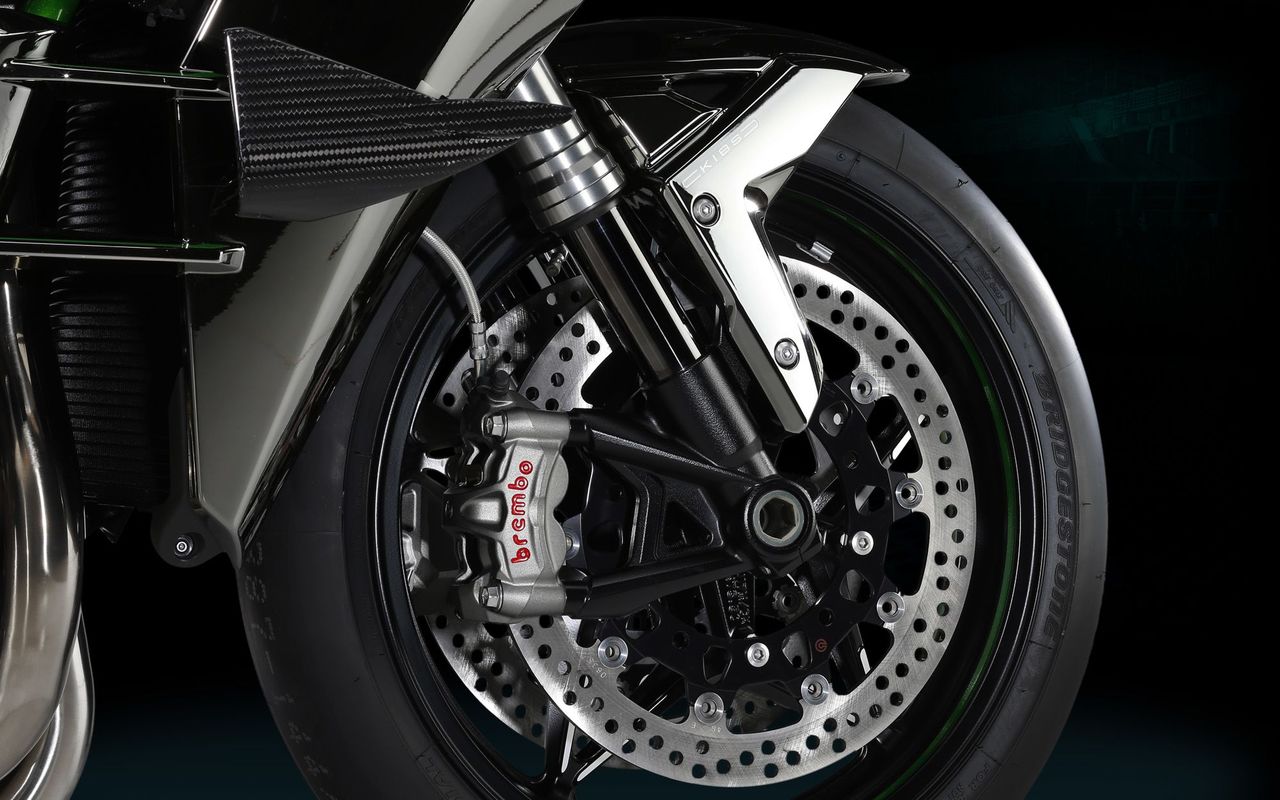
Kawasaki ABS systems use front and rear wheel sensors to constantly monitor wheel speed. Should information from either of the sensors indicate that wheel lock has occurred, the ABS ECU directs the pump in the ABS unit to modulate brake fluid pressure (releasing and reapplying pressure so that traction can be regained) until normal operation resumes. ABS offers rider reassurance that contributes to greater riding enjoyment.
KIBS (Kawasaki Intelligent anti-lock Brake System)
Kawasaki developed KIBS to take into account the particular handling characteristics of supersport motorcycles, ensuring highly efficient braking with minimal intrusion during sport riding. It is the first mass-production brake system to link the ABS ECU (Electronic Control Unit) and engine ECU.
In addition to front and rear wheel speed, KIBS monitors front brake caliper hydraulic pressure, throttle position, engine speed, clutch actuation and gear position. This diverse information is analyzed to determine the ideal front brake hydraulic pressure. Through precise control, hydraulic pressure is modulated in much smaller increments than with standard ABS systems. The system limits rear wheel lift under heavy braking and takes downshifting into account while braking, allowing the rider to manage the rear brake. And because of the finer control, kickback to the brake lever is minimal, resulting in a very natural feeling.
Silver-Mirror Paint
Kawasaki’s high-quality original paint has a highly reflective, glasslike metal appearance. Its debut on the 2015 Ninja H2™ and Ninja H2™R marked its first use on a mass-production vehicle in either the automotive or motorcycle industry.
In the shade the paint has the appearance of its base coat color, but once in the sunlight its highly reflective surface takes on the appearance of the surrounding scenery. The stark difference in the way the paint appears in the light and the shade emphasizes the sculpted shape of the bodywork on which it is applied.
The highly reflective surface is created by inducing a silver mirror reaction (a chemical reaction between a solution of silver ions and a reducing agent) that forms a layer of pure silver (Ag). This Ag layer is what creates the paint’s glasslike metal appearance. Compared to candy paints, which use aluminum flakes to generate a sparkling effect, the Ag layer appears as a uniform metallic surface.
In the shade the Ag layer is translucent, allowing the base coat color to show through. This gives the paint a deep, three-dimensional quality.
While the multiple layers of paint on typical mass-production models are done by robot painters, for this silver-mirror paint each layer – from primer to clear coat – is carefully finished by the hands of Kawasaki craftsmen to ensure a flawless, lustrous surface.
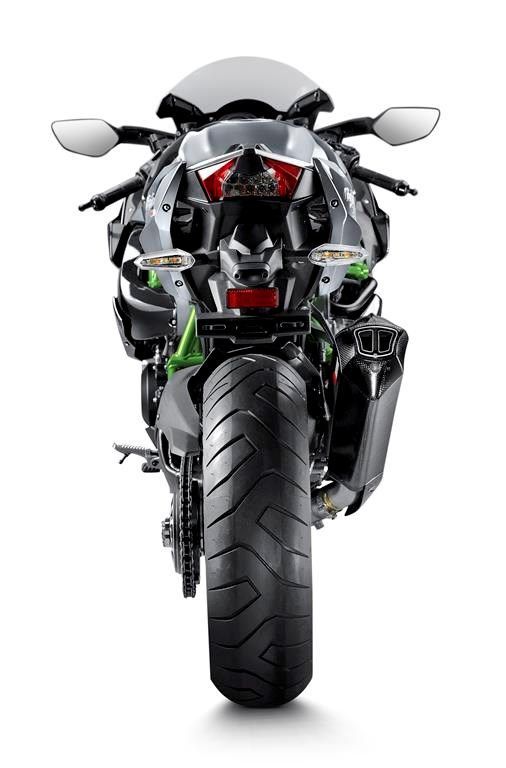
Specs
Engine : 998cc, four-cylinder, supercharged engineLiquid - cooled, 4-stroke, In-Line Four, DOHC, 16-valve
Displacement : 998cc
Bore x Stroke : 76.0 x 55.0mm
Compression Ratio : 8.5:1
Fuel System : DFI® with 50mm throttle bodies (4) with dual injection ; Kawasaki Supercharger
Ignition : Digital
Transmission : 6-speed, return, dog-ring
Final Drive : Sealed chain
Maximum Torque : 104.9 lb-ft @ 11,000 rpm
Maximum Power : 243 hp


















